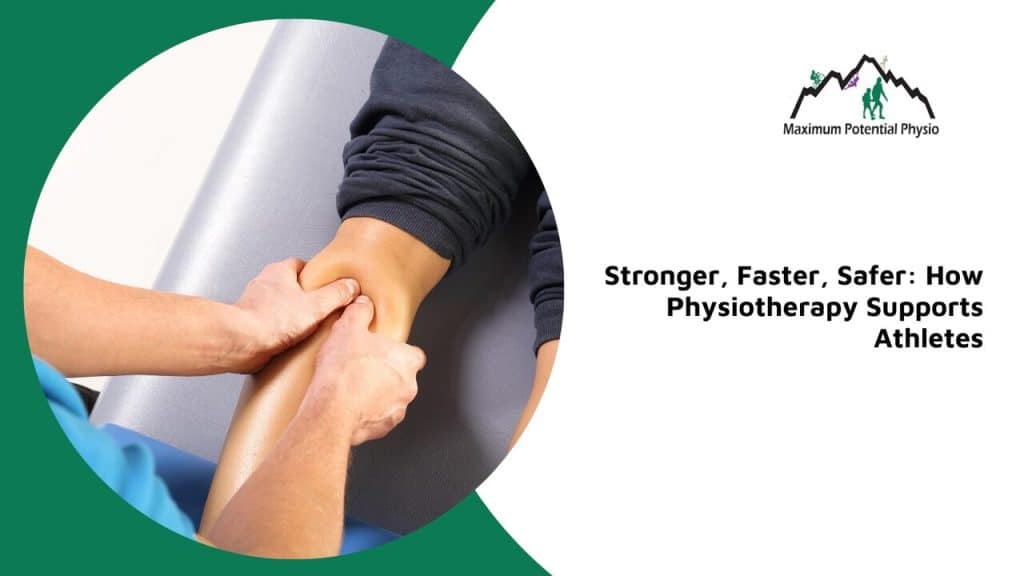Stronger, Faster, Safer: How Physiotherapy Supports Athletes

Athletes constantly push their bodies to the limit, striving for peak performance and enduring rigorous training schedules. While this dedication brings rewards, it also increases the risk of injury, fatigue, and performance plateaus. Physiotherapy bridges the gap between these challenges and success, offering evidence-based techniques that promote recovery, enhance performance, and prevent injuries. In this blog, we’ll explore how physiotherapy benefits athletes at every level—whether recovering from a sprain or fine-tuning their biomechanics for optimal results.
How Physiotherapy Benefits Athletes
Physiotherapy offers athletes a range of benefits that support both their short-term recovery and long-term performance. These include:
- Injury Prevention: By identifying muscle imbalances, poor movement patterns, and overuse risks, physiotherapists create tailored strategies to reduce the likelihood of injuries.
- Faster Recovery: Whether recovering from an injury or a strenuous workout, physiotherapy techniques like massage and stretching speed up the healing process.
- Improved Mobility: Physiotherapy enhances flexibility and joint mobility, allowing athletes to perform movements more efficiently and with less risk of strain.
- Pain Management: Non-invasive techniques, including manual therapy and taping, alleviate pain and support healing without relying on medication.
These benefits extend beyond recovery, giving athletes the tools to achieve consistent improvement in their sport.
Common Sports Injuries Physiotherapy Can Address
Physiotherapy is a cornerstone in treating a wide range of sports injuries, offering targeted care that promotes recovery and prevents recurrence. Common injuries include:
- Sprains and Strains: Whether it’s a twisted ankle or pulled hamstring, physiotherapy reduces pain and restores strength and flexibility to the affected area.
- ACL and Other Knee Injuries: These are frequent in sports requiring quick directional changes. Physiotherapy focuses on rebuilding stability and strength in the knee joint.
- Rotator Cuff Injuries: Common in overhead sports like tennis or swimming, these shoulder injuries benefit from strengthening and mobility exercises.
- Shin Splints: A common issue for runners, physiotherapy addresses the root causes, such as poor biomechanics or overtraining.
- Tendinopathies: Conditions like tennis elbow or Achilles tendinitis are treated with manual therapy, stretching, and strengthening exercises.
By addressing the root causes of these injuries, physiotherapy ensures athletes return to their sport safely and with reduced risk of re-injury.
Improving Athletic Performance: The Role of Physiotherapy
Physiotherapy plays a significant role in enhancing athletic performance by focusing on biomechanics, strength, and recovery. A physiotherapist analyzes the athlete’s movements to identify areas for improvement, such as reducing energy wastage or correcting imbalances that hinder efficiency.
Targeted strengthening exercises are integral to physiotherapy’s performance-enhancing benefits. By building muscle groups essential for the sport, athletes can generate more power and endurance. Flexibility training complements this by increasing range of motion, enabling smoother and more effective movements.
Recovery is another critical component. Techniques like soft tissue massage and active recovery sessions reduce muscle soreness and improve recovery times. This allows athletes to train more consistently without overtraining or risking injury.
Finally, physiotherapists often develop personalized programs that align with an athlete’s goals, focusing on specific areas like agility, coordination, or explosive power. This comprehensive approach ensures performance gains are both measurable and sustainable.
Preventing Injuries With Physiotherapy
Physiotherapy helps athletes adopt proactive strategies to prevent injuries and maintain peak performance, including:
- Regular Biomechanical Assessments: Identifying and correcting movement inefficiencies, such as improper running or lifting techniques, minimizes strain and overuse injuries.
- Strength and Flexibility Training: Targeting weak muscle groups and improving flexibility provides better support for joints, reducing the likelihood of strains or sprains.
- Proper Warm-Ups and Cool-Downs: Dynamic warm-ups prepare muscles and joints for activity, while cool-down stretches promote recovery and reduce stiffness.
- Proprioceptive Training: Balance and coordination exercises, such as using balance boards or stability balls, improve stability and help prevent falls or sudden injuries.
- Customized Recovery Plans: Incorporating active recovery sessions and modalities like massage or cryotherapy helps manage muscle fatigue and prevent overtraining.
These preventative measures, guided by a physiotherapist, empower athletes to sustain long-term physical health and performance.
Is Physiotherapy Beneficial for Non-Professional or Amateur Athletes?
Physiotherapy isn’t limited to professional athletes; it offers significant benefits for amateur and recreational athletes as well. Engaging in sports at any level can lead to injuries, muscle imbalances, or overuse issues, and physiotherapy provides effective solutions to these challenges.
For amateur athletes, physiotherapy focuses on improving biomechanics, strength, and flexibility to prevent injuries and enhance performance. For example, a recreational runner may benefit from gait analysis and exercises to correct improper running form, reducing the risk of shin splints or knee pain.
Additionally, physiotherapy helps manage the physical strain associated with new or increased activity levels, guiding athletes through safe training techniques and recovery practices. Whether preparing for a local marathon or simply staying active, non-professional athletes gain confidence and resilience through physiotherapy.
Physiotherapy for Athletes: Commonly Used Techniques
Physiotherapists employ a variety of evidence-based techniques and treatments to support athletes, including:
- Manual Therapy: Joint mobilization and soft tissue massage reduce stiffness, alleviate pain, and restore mobility in affected areas.
- Therapeutic Exercises: Targeted exercises strengthen muscles, improve joint stability, and enhance overall endurance, tailored to the athlete's needs.
- Heat and Cold Therapy: Cold therapy minimizes swelling and inflammation, while heat therapy increases blood flow and relaxes muscles.
- Proprioceptive Training: Balance-focused exercises improve coordination and reduce the risk of recurrent injuries.
These treatments are combined into a personalized plan to address immediate recovery needs and support long-term performance goals.
Athletic Longevity: The Role of Physiotherapy
Athletic careers, whether professional or recreational, can be extended significantly with the support of physiotherapy. By focusing on injury prevention and long-term physical health, physiotherapy helps athletes maintain their performance and stay active for longer.
One of the key contributions of physiotherapy to athletic longevity is its ability to identify and address potential problems early. Regular assessments ensure that minor issues, such as muscle tightness or movement inefficiencies, are resolved before they escalate into serious injuries.
Physiotherapy also emphasizes sustainable training practices, helping athletes balance intensity with recovery to avoid burnout or chronic overuse injuries. Through targeted exercises, physiotherapists strengthen muscles, improve joint stability, and enhance flexibility, all of which support long-term physical resilience.
For aging athletes, physiotherapy is particularly valuable in managing age-related changes such as reduced bone density or muscle strength. By adapting training and recovery strategies, physiotherapy ensures that athletes of all ages can continue to enjoy their sport.
How Often Should Athletes Undergo Physiotherapy Sessions?
The frequency of physiotherapy sessions for athletes varies depending on their needs, goals, and current physical condition. For athletes recovering from an injury, sessions may initially be more frequent, such as two to three times per week, to address pain, inflammation, and mobility. As recovery progresses, the frequency typically decreases to once a week or less, focusing on strength-building and functional movement.
For those using physiotherapy as a preventative measure, a monthly session is often sufficient to monitor progress, address potential issues, and maintain optimal physical health. During intense training or competition periods, more frequent sessions can help manage the increased strain on the body and prevent injuries.
Consistency is key. Athletes who integrate physiotherapy into their routine experience better recovery, improved performance, and fewer injuries over time. A personalized plan, developed in collaboration with a physiotherapist, ensures the right balance of therapy and training.
Adjusting Physiotherapy Exercises for Different Sports
Physiotherapy exercises are tailored to the unique physical demands of various sports. Some examples include:
- For Soccer Players: Exercises like squats, lateral lunges, and plyometric drills improve lower body strength, agility, and explosive power.
- For Swimmers: Resistance band exercises for shoulder mobility and planks for core stability reduce the risk of shoulder injuries common in overhead movements.
- For Tennis Players: Rotational core exercises, such as Russian twists and medicine ball throws, enhance balance and power for precise strokes.
- For Runners: Gait training and targeted strengthening exercises like step-ups and single-leg deadlifts prevent shin splints, IT band syndrome, and other running-related injuries.
- For Weightlifters: Exercises focused on joint stabilization, such as isometric holds and resistance band work, prevent overloading and enhance joint safety.
By aligning exercises with the demands of specific sports, physiotherapists help athletes enhance performance and reduce injury risk.
Reach New Heights of Athletic Performance
Ready to take your athletic performance to the next level? Physiotherapy isn’t just about recovery—it’s a game-changer for injury prevention, performance optimization, and long-term physical resilience.
Whether you’re a seasoned professional or an amateur enthusiast, personalized physiotherapy with the team at Maximum Potential Physiotherapy in Calgary NW can help you achieve your goals safely and effectively. Contact us today to create a plan that empowers you to perform at your best, every time you step into your sport.

